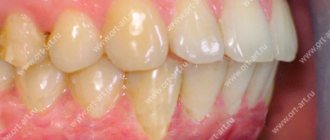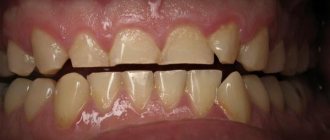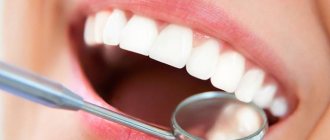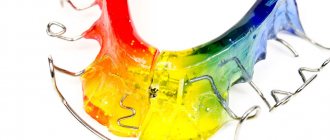- Signs of correct bite
- Types of malocclusion
- Why do you need to correct your bite?
- Until what age can a bite be corrected?
- Ways to correct a bite
- Aligners
- Trainers
- Veneers
- Bracket system
- Types of braces
- Which braces system should you choose?
- How long does it take to correct a bite?
- How to care for braces?
Malocclusion occurs in almost 80% of the Russian population. In a third of cases it requires orthodontic treatment. And it’s not just a matter of aesthetics - if you are often bothered by headaches, earaches and dizziness, then perhaps it’s a malocclusion. An orthodontist deals with the correction and prevention of malocclusions.
The most common misconception about bite is related to age. Many people think that it can only be corrected in childhood, but today, with the advent of new technologies, this can be done at any age.
In this article we will look at the causes and types of malocclusion and why it needs to be corrected. We will also tell you about treatment methods and dispel the most common fears. Orthodontist Olesya Milagina comments on current issues of orthodontic treatment for us.
Signs of correct bite
To begin with, we will show what a normal bite looks like and list the signs by which you can understand that it is normal.
- The main distinguishing feature of a correct bite is the tight contact of the upper and lower jaws when they close. The upper front teeth cover the crowns of the lower ones by a third, that is, the lower incisors come into contact with the palatine tubercles of the upper ones. There is no distance between the upper and lower chewing teeth, and during chewing they are in constant contact.
- Correct bite affects the harmony of facial proportions: the lower and upper jaws are symmetrical.
- There are no speech defects.
- Food is comfortable to bite and chew.
- There is no discomfort or clicking in the jaw joint.
What to choose
What is better, braces or aligners, is not determined by the cost item. The cost of mouth guard correction is offset by many benefits. In addition to the speed of correction, the patient receives aesthetics and wearing comfort, which is due to the design of the plates. The person will not experience embarrassment, as often happens with braces. There is no need to be ashamed of your smile and laughter, or purse your lips during a conversation.
There are no dietary restrictions when wearing mouth guards. You can eat solid foods after removing the product from your mouth. It is impossible to remove the braces temporarily, so you will have to give up some food, otherwise the structure may be damaged. After eating, you need to rinse your mouth thoroughly and brush your teeth, as food debris gets stuck in the locks. Difficulty with oral hygiene leads to the formation of caries and additional treatment, whereas such problems do not arise with aligners. Eating and brushing your teeth are no different.
If you have any doubts about the treatment method, sign up for a consultation at PROPRICUS dentistry. The doctor will conduct a diagnosis, assess the condition of the oral cavity and recommend an orthodontic design model that will eliminate the identified defects. We provide comprehensive services, including examination, choice of treatment method, preparation of the impression, attachment of the device, as well as regular monitoring. We eliminate even complex deformities using aligners and provide painless treatment. Clients of the clinic can expect a cozy atmosphere, fast and professional service.
Types of malocclusion
How can you tell if your bite is wrong? Essentially, these are all deviations from the norm that nature has established.
Malocclusion occurs:
- distal - the upper jaw is pushed forward more than the lower jaw;
- mesial - the lower jaw is pushed forward more than the upper jaw;
- deep - the upper teeth overlap the lower ones by more than half their length;
- open - most of the teeth of the upper and lower jaws do not meet;
- cross - the left and right sides of the upper dentition protrude forward unevenly, and the upper and lower teeth meet with cutting edges.
Content
- The impact of malocclusion on health
- Making a choice
- Removable type of braces for adults
- Popular braces
- What is a retainer?
- Systems for teenagers
- For children
- Do your teeth hurt during treatment?
- How to care for your oral cavity?
- Pain after removal
A beautiful smile can work wonders.
People who regularly show their teeth are more successful in life than those who don't. But what to do if nature has not given you the opportunity to smile? The most common reason for this is uneven teeth. A person becomes unsure of himself and begins to communicate less with people. In a word, he develops an inferiority complex. But there is a solution to this problem. Medicine is developing rapidly, and now anyone can get dental braces. With their help you can correct your bite. Moreover, this can be done quite quickly. For example, advanced cases take five years - this is exactly the period required to straighten the teeth.
But not everyone decides to get braces. Why? The fact is that most people are subject to stereotypes. Malocclusion occurs in 70% of the world's population. And what part of them do you think undergo treatment with braces? Less than half! And all because they consider it ineffective and painful. But that's not true.
After all, modern orthodontics offers a huge variety of designs that have different effects on teeth and look different. People who are involved in public life are often concerned about aesthetic issues. This is due to the fact that they have to interact with more people, which will be more difficult to do with designs that, in their opinion, are repulsive. As we have already said, there are different types of braces systems, and one of them is ceramic. It is white in color, so it easily “adjusts” to the natural color of the teeth.
Why do you need to correct your bite?
- Increased abrasion, caries and tooth loss.
Normally, when chewing, the load is evenly distributed across all teeth. When there is a malocclusion, the load on some teeth increases, while on others there is practically no load. On teeth that “work for two,” the enamel wears off faster, chips appear, and the teeth themselves become loose. Teeth that are “resting” are more vulnerable to caries. - Gum diseases.
With an incorrect bite, the teeth can be tilted inward or, conversely, turned toward the lips. Eating or even normal conversation can injure the inside of the cheeks and tongue. The gums also suffer: the volume of tissue gradually decreases, exposing the roots of the teeth. - Diseases of the temporomandibular joint.
Incorrect positioning of the incisors over time leads to displacement of the jaw joints relative to each other. The pathology is accompanied by muscle spasms, bruxism, crunching and clicking while eating or talking. - Diseases of the food tract.
The bite is responsible for chewing and swallowing, and defects in the bite disrupt this process. Poorly chopped products are an additional burden on the gastrointestinal tract, which provokes gastritis, enterocolitis and problems with stool. - Breathing problems and ENT diseases.
The accumulation of bacteria in the mouth during an open bite can cause sinusitis, sinusitis, otitis media, and sore throat. - Communication problems and complexes.
For 60% of patients, braces are aesthetics; for the remaining 40%, it is either the functionality of the masticatory apparatus, or a solution to a problem with the temporomandibular joint, or a preparatory stage before prosthetics.
Differences between aligners and braces
There are several differences, but they are significant:
- Aesthetics – unlike braces, plastic aligners are not visible.
- Mechanics of influence - aligners apply even pressure on all teeth, with simultaneous rotation and displacement in a given direction due to their tight coverage. Braces provide consistent displacement in the desired direction and rotation.
- Removable - the aligners are removable, there is no need to change your diet, and oral hygiene is simplified.
- Allergenicity - aligners are made of hypoallergenic plastic, and most models of braces are made of metal.
- Installation time – the plates are installed in 45-60 minutes. Fixed models - in 3-6 hours.
- The treatment period with mouth guards is 30% faster.
When wearing braces, there is a risk of tooth decay. This is impossible with aligners. There is no need to use cleaning brushes or dental floss to care for your aligners. For non-removable systems, the use of cleaning devices is mandatory. A patient who wishes to purchase polymer plates can see the final result before starting treatment.
Ways to correct a bite
Today there are four ways to correct a bite and one way to carefully disguise the problem.
- Aligners
- Trainers
- Bracket systems
- Surgical intervention
We have listed these methods in order from easiest to most difficult. You must understand that each case is individual, and depending on this, the doctor will select the optimal bite correction system. You can hide an unaesthetic bite with the help of veneers - we will also talk about them.
Aligners
Removable aligners that are created from dental impressions. The most modern way to correct a bite, which is suitable for the treatment of simple disorders.
After drawing up a treatment plan, the patient receives 3–5 sets of aligners of varying stiffness. The mouth guard is designed to last for two weeks, and then it needs to be changed to the next one, and so on until the final result. The course of treatment lasts on average 4–8 weeks.
Aligners need to be worn 24 hours a day, and this may not be comfortable for everyone. They are not suitable for deep bites. The mouthguard is designed so that it is “one step” ahead of the current position of the teeth in the dentition. Therefore, after putting it on, pressure is felt, which is evenly distributed throughout the jaw. Aligners consist of an elastic transparent material, so they are invisible to others, unlike braces.
Trainers
Removable silicone mouth guards for two jaws, which help correct a simple bite or consolidate the result. You need to wear the trainer during sleep and during the day for up to 4 hours.
Veneers
The characteristics are similar to crowns, but they are installed only on the front surface of the tooth in the form of a thin plate on a special dental glue.
Veneers can be composite, ceramic or zirconium. The first two types last about 10 years. Products made of zirconium dioxide with external porcelain coating - up to 15 years.
Veneers eliminate defects that arise as a result of cracks or damage to the integrity of teeth. A visually straight dentition is formed.
For the patient, the result of orthodontic treatment is aesthetics, and for the doctor, it is functionality. If your teeth are just crooked and your bite is perfect, you can get veneers or crowns. In other cases, you cannot do without braces: veneers do not correct the position of the teeth, but only mask their external imperfections.
Bracket system
Braces are small clasps that are attached to the teeth with a special composite glue. A metal arch is placed in the grooves of the braces - the most important element of the braces system. The arch has the shape of a regular dentition. She pulls her teeth, setting them in the correct position. In order for the bracket system to successfully complete its work, it is important to periodically change the arches to more elastic ones.
The doctor fixes the arch on the braces with special rubber bands - ligatures. Depending on the task at hand and the required force that will act on each tooth and jaw as a whole, the orthodontist can choose metal or elastic ligatures. The latter have a clear advantage - when they are changed, you can get rid of the bacteria accumulated under them.
Increased salivation in the first days after installation is a good reaction of the body. The tongue contains sensory neurons that, when food appears in the mouth, send signals to the brain to turn it into a food bolus. When braces are put on your teeth, at first the brain perceives them as food. This is the body’s reflex that there is something in the mouth, which means it needs to be treated with saliva in order to then swallow it. After some time, the salivary glands will get used to it.
Does it hurt to wear braces?
The first days are unusual, but not painful. But if braces scratch your lips and cheeks, you shouldn’t tolerate it. “ Make an appointment with your orthodontist. Sharp elements can be corrected with special materials and filled with special wax
“, our expert advises.
The same applies to tooth sensitivity: sign up for a diagnosis. It is possible that areas of demineralization have appeared. Depending on what the teeth react to, further treatment will depend.
Types of braces
Braces are classified according to the following criteria:
- material (metal, plastic, ceramic and sapphire);
- technique (classical and self-ligating, without ligatures);
- Place of installation (on the outer surface of the teeth - vestibular, on the inner surface - lingual).
Metal braces
Despite the fact that these are the oldest braces systems, they are still popular, and not only because they are the cheapest. Their main advantage is the minimal friction force between the groove and the arc, the magnitude of which largely determines the duration of the entire treatment.
The only negative is that such braces are noticeable on the teeth. However, modern designs differ from their ancestors - they are smaller and more convenient.
Plastic braces
Second after metal ones in the price range. Since plastic itself is not strong enough, the design has metal grooves. Their disadvantage is that such braces are stained by coffee, tea and other coloring products. They are also more fragile than others. However, plastic braces come in a variety of colors and shapes and are therefore popular in pediatric orthodontics.
Ceramic braces
More expensive, but stronger than plastic ones. The color matches the color of the teeth, which makes them almost invisible. Their disadvantage is higher friction between the arch and the bracket slot, which can increase the duration of treatment.
Sapphire braces
Artificial sapphires are used to make them. They are transparent and shimmer beautifully in certain lighting. This design will appeal to those who are sensitive to aesthetics.
Combined braces
Consist of several materials. In the smile area it can be ceramics or sapphires, and in the chewing area it can be metal.
Lingual braces
They are attached to the inside of the teeth and are invisible to others. Their main disadvantage is their high cost. Also, at first they may interfere with diction, but after 2-3 weeks the language adapts and the problem goes away.
Is it possible to correct a bite at 30–40 years old?
Typically, jaw position adjustments begin in childhood. Parents concerned about improper tooth growth often turn to orthodontists with the question of at what age to begin correcting the bite, and until how many years this can be done.
Correction of bite at 30 – 40 years old
Not all pathologies can be treated until permanent teeth and jaw bones are fully formed. Sometimes you have to wait until the age of 12–14, but by then the child has already gotten used to his appearance and does not pay attention to the crooked teeth. Problems appear later, when after 40 years the jaw joints begin to ache, the enamel becomes thinner, caries develops, diction deteriorates, breathing difficulties, headaches, and insomnia appear.
Therefore, even if in adolescence it was not possible to correct the bite, and this thought came to you again only at the age of 30, it is not too late to start making adjustments. And the only correct answer that a patient should hear from an orthodontist to the question at what age can a bite be corrected is that it’s never too late to start.
Yes, in adulthood the treatment is more difficult both psychologically and physiologically. But, having dealt with the problem at 25–30 years old, a person will be able to charm with his smile at 35–40.
The hardest thing is to mentally adjust to wearing braces. This therapeutic accessory is considered a teenage one. But modern devices can be almost invisible to others. And in some cases, it is possible to do without wearing braces. A qualified orthodontist will advise you on the right decision.
Which braces system should you choose?
The least expensive and most proven option is metal braces. Plastic ones are also inexpensive, but they are inferior in strength to metal ones. If aesthetics are more important to you, opt for more expensive ceramic, sapphire or lingual braces.
As for “internal” braces, their only difference from all others is the aesthetic factor. One of the inconveniences is that such braces change the diction, they are more difficult to care for and they are not suitable for everyone. You need to have an almost perfect bite: just “uneven teeth.”
Removable type of braces for adults
Dental orthodontics offers removable and non-removable structures. Now let's talk about the first ones. They can only be used in cases of slight displacement. Removable aligners are also called aligners, and they must be worn at least 22 hours a day, and cannot be removed during this time. There are people who believe that removable systems can quickly correct the situation, and therefore, bite correction with braces is carried out within 2-3 hours of wear a day or by putting it on only at night. It is worth understanding that there will be no result from such treatment.
Correcting a bite with a brace system should be conscious. Wearing it requires self-discipline. Therefore, if you don’t have one, maybe it’s better to install a non-removable system? Of course, the final decision rests with the doctor, but he must take your wishes into account.
How long does it take to correct a bite?
Each case is individual, so without visiting a doctor it is impossible to say how long treatment will take.
The minimum treatment takes a year for the bone to grow and the teeth not to come back. The result needs to be stabilized. Patients often tell me after two months of wearing braces: “I want to take them off, everything is already straight for me!” But this is appearance. The jaw bones must anchor the teeth into their new position.
The duration of treatment also depends on the patient. The orthodontist puts a certain force into the braces, which weakens by the next visit. That is why it is important to strictly visit the doctor once a month so that you do not have to prolong the course of treatment.
My teeth began to loosen. Something is going wrong?
Loose teeth after installation should not scare you. The teeth will be in motion throughout the treatment period. Essentially, we move our teeth: somewhere the bone dissolves, somewhere it appears. Six months after treatment, the teeth will return to normal.
The purpose of braces is to change the position of hard and soft tissues adjacent to the tooth. But this is not enough to correct the bite. Teeth may move back apart some time after braces are removed if a retention device is not in place. After correction, retainers must be installed to keep the teeth stable in their new position. If this is not done, the effect of wearing braces will gradually disappear.
How often is orthodontic treatment needed?
As an orthodontist with more than 20 years of experience, a large number of patients pass through me. But even with my experience in orthodontics, I meet people who refuse to believe and do not understand the whole situation with the malocclusion of their teeth.
In our team of dentists, we also specialize in orthodontics. After all, a person often comes to dentistry simply with a problem of caries or pain, and then the doctor, without actually imposing anything on him - without selling, tells him “everything as it is,” and the patient falls into a stupor, thinking “well, how can this be! I just came to put a filling...”
Let's talk about the ability of patients to recognize the problem of malocclusion. And also - why correct the bite and how to correct the bite.
In fact, many people are not prepared for what the doctor will tell them.
With such patients one has to follow a certain pattern of behavior. That is, we meet for the first time, I tell him that the person heard something, he has not yet realized it.
Then he comes the next time, we repeat this conversation, only with details, and until I see that the person himself wants to change something in his body, until he himself wants it, I do not take him into treatment. Why? Because everyone knows that 50% of the success of treatment depends on the patient himself; if he is motivated and wants to understand how to correct a malocclusion, everything will work out; the doctor alone cannot do it.
Often in our practice, especially with adult patients, we use an interdisciplinary approach together with surgeons, implantologists and orthopedists. Because, as a rule, when a patient seeks orthodontic treatment, it turns out that there are still a number of issues that need to be resolved with doctors of other specializations. At this moment, we do comprehensive consultations that last an hour and a half, and as a result of this consultation, our patient has an understanding of what will need to be done in order to achieve the desired result.
How to care for braces?
Caring for braces requires care and discipline. We talked about it in more detail in a separate article. After installing braces, the doctor will tell you how to live now. We will indicate the most important things.
- Always have brushes and a single-tuft brush on hand.
- Add a waterpik to your arsenal.
- If you are not sure that you have brushed your teeth well, use an indicator tablet. After brushing your teeth, the tablet must be dissolved in your mouth. The areas where plaque remains will turn blue. These areas need to be cleaned again.
- Avoid very hot and very cold drinks. Braces, like enamel, do not like sudden temperature changes.
- To prevent braces from coming off, follow a diet. Eliminate nuts, toffees, seeds, and flour from your diet. Apples and other hard fruits should not be bitten off, but cut into small pieces and placed on the chewing teeth.
Enamel deteriorates due to braces
When correcting a bite, braces are fixed to the surface of the enamel, and it stops being washed with saliva. This may weaken it, but with proper dental care and sufficiently effective self-hygiene, dental health is not in danger. To ensure that teeth remain healthy after bite correction, remotherapy is carried out before installing braces, professional hygiene is periodically performed during the treatment period, and the condition of the teeth is regularly monitored.











